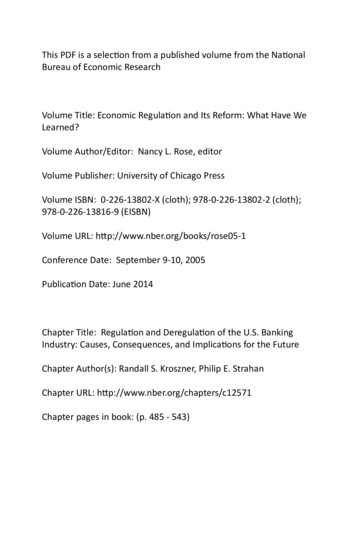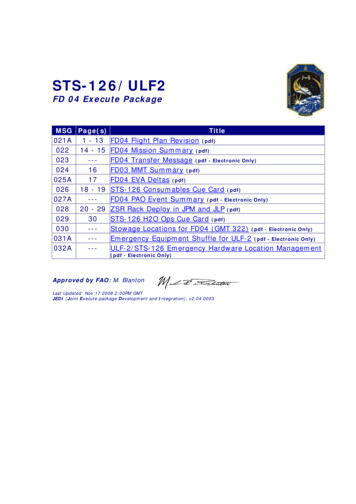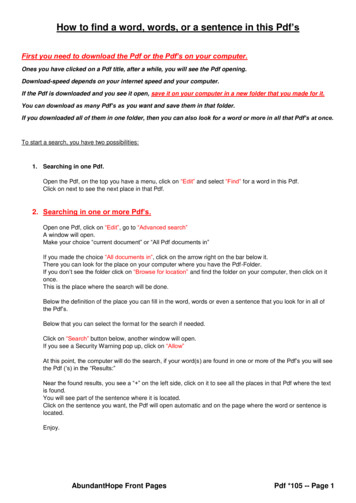
Transcription
This PDF is a selec on from a published volume from the Na onalBureau of Economic ResearchVolume Title: Economic Regula on and Its Reform: What Have WeLearned?Volume Author/Editor: Nancy L. Rose, editorVolume Publisher: University of Chicago PressVolume ISBN: 0‐226‐13802‐X (cloth); 978‐0‐226‐13802‐2 (cloth);978‐0‐226‐13816‐9 (EISBN)Volume URL: h p://www.nber.org/books/rose05‐1Conference Date: September 9‐10, 2005Publica on Date: June 2014Chapter Title: Regula on and Deregula on of the U.S. BankingIndustry: Causes, Consequences, and Implica ons for the FutureChapter Author(s): Randall S. Kroszner, Philip E. StrahanChapter URL: h p://www.nber.org/chapters/c12571Chapter pages in book: (p. 485 ‐ 543)
8Regulation and Deregulationof the US Banking IndustryCauses, Consequences, andImplications for the FutureRandall S. Kroszner and Philip E. Strahan8.1IntroductionThe banking industry has been subject to extensive government regulationcovering what prices (that is, interest rates) banks can charge, what activitiesthey can engage in, what risks they can and cannot take, what capital theymust hold, and what locations they can operate in. Banks are subject to regulation by multiple regulators at both the state and federal level. Each statehas its own regulatory commission. At the federal level the primary bankregulators are the Office of the Comptroller of the Currency (OCC), theFederal Deposit Insurance Corporation (FDIC), and the Federal ReserveBoard. Even banks that operate at a single location are likely to be regulatedby at least one state and two federal bodies.The banking industry also plays a significant part in both the financialsystem and the economy as a whole. The importance of the banking industrygoes beyond its mere size; numerous studies (as we describe later) have shownthat the health of this sector has significant effects on overall economicactivity, as well as the size and persistence of economic cycles. Banks (alongRandall S. Kroszner is the Norman R. Bobins Professor of Economics at the Booth Schoolof Business and was formerly a governor of the Federal Reserve System; he is also a researchassociate of the National Bureau of Economic Research. Philip E. Strahan is the John L. Collins Professor of Finance at Boston College and a research associate of the National Bureauof Economic Research.We would like to thank participants in the NBER regulation conference for helpful comments, particularly the discussant Charles Calomiris, Jonathan Macey, and Nancy Rose. Thanksalso to William Melick and seminar participants in the Bundesbank. Randall S. Kroszner isgrateful for support from the Stigler Center for the Study of the Economy and the State at theGraduate School of Business of the University of Chicago. For acknowledgments, sources ofresearch support, and disclosure of the authors’ material financial relationships, if any, pleasesee http://www.nber.org/chapters/c12571.ack.485
486Randall S. Kroszner and Philip E. Strahanwith other financial institutions) encourage and collect savings that financeeconomic growth. By allocating that savings and monitoring the use of thosefunds, banks play an integral role in assuring the productivity of resourceuse throughout the economy. Banks are also a crucial provider of liquidityto both individuals and firms, and this role becomes particularly importantin times of economic stress and crisis. The quality of bank regulation, whichaffects the stability, efficiency, and size of the sector, thus has an importanteffect on the level and volatility of economic growth.Regulation of banking has undergone tremendous change over time, withextensive regulations put into place in the 1930s, and later removed in thelast quarter of the twentieth century. This deregulation has been accompanied by a dramatic reduction in the number of banking institutions in theUnited States, but not an increase in banking concentration at the local level.Regulatory change has been driven by both macroeconomic shocks as wellas competition among interest groups within banking and between banksand other financial services providers. As we show, the role of both privateinterests and public interests play a key part in the analysis.This chapter was completed and presented at an NBER conference in2005, prior to the financial crisis of 2008. One of the themes that we developed was the importance of “market adaptation” to regulatory constraints.By “market adaptation,” we mean actions and innovations undertaken bybanks and their competitors to circumvent or reduce the costs of regulation.One of the consequences of market adaptation was to provide incentives forthe creation of alternative institutions and markets competing with but alsoconnected to the banking system. This web of alternative institutions andmarkets is now loosely referred to as the “shadow banking” sector. Whilewe will keep the bulk of the chapter as it was, we have added an epilogueto show how “market adaptation” may have contributed to fragilities thatset the conditions for the financial crisis. We also touch briefly on postcrisisregulatory responses, such as Dodd-Frank and Basel III. Since many, ifnot most, of the postcrisis responses are yet to be implemented or will bephased in over many years, we will not be able to undertake the same detailedempirical analysis of the post- 2008 regulatory responses that we do for theregulation from the financial crisis of the 1930s until the early 2000s.This chapter has four main goals. First, we provide an overview of themajor regulations that have affected the structure and efficiency of thebanking industry. In section 8.2 we explain the origins of state and federal banking regulation and briefly describe how the laws and regulationshave evolved. We focus on five areas: restrictions on entry and geographicexpansion; deposit insurance; product- line and activity restrictions; pricingrestrictions; and capital regulation.Second, we evaluate the consequences of these regulations for the banking industry as well as for the financial system more broadly. Glass-Steagallregulation, to take one example, prevented commercial bank involvement
Regulation and Deregulation of the US Banking Industry487in the corporate bond and equity underwriting businesses until its recentrepeal. Glass-Steagall not only kept commercial banks from competing withinvestment banks, but also spawned a variety of innovations and institutionssuch as venture capital to substitute where banks could not go. As noted earlier, “market adaptation” to regulatory constraints has generated change inthe banking and financial services industry, as banks and their competitorsattempt to circumvent the costs of regulations. Moreover, a regulation thatat one point helped the industry may later become a burden and hence sowthe seeds of its own demise. Interest rate restrictions that eliminated pricecompetition among banks, for example, lost the support of the industrywhen new financial institutions and markets emerged to provide market ratesof interest on checking- like accounts (e.g., the Merrill Lynch Cash Management Account from the 1970s). The first half of section 8.3 provides a briefoverview of such consequences, adaptations, and regulatory responses.Third, we investigate some of the real effects of bank regulatory change,on both the industry and the economy. The elimination of geographicrestrictions on bank expansion that limited competition, for example, hadpositive consequences on the industry (by reducing the riskiness of banksand increasing their efficiency), on credit supply (by providing lower pricingof loans), and on the economy (by increasing economic growth and reducing economic fluctuations). Deregulation of restrictions on geographicalexpansion and product lines also led to a more consolidated but generallyless locally concentrated banking system dominated by large and diversifiedbanking organizations that compete in multiple markets.Fourth, we provide a positive explanation for regulatory change (section8.4). A variety of technological, legal, and economic shocks have altered therelative strengths, effectiveness, and interests of different groups competing for support or reform of banking regulation. The development of theautomated teller machine (ATM) in the early 1970s, for example, reducedthe value of geographic protections to smaller local banks, thereby reducingtheir willingness to fight to maintain restrictions on branching. A numberof court decisions also changed the impact of long- standing regulations inareas such as usury ceilings. Economic crises, either system wide, as in the1930s, or to parts of the financial system, as in the savings and loan crisis ofthe 1980s, have also had important distributional impacts that led to regulatory change. We provide some explanations for both the timing of regulatorychanges broadly, and for the patterns of change across states.Finally, in the epilogue, we describe briefly how many of the themes wesaw develop in the seven decades following the Great Depression, suchas market adaptation to regulation, accelerated during the 2000s and setthe stage for the 2007– 2008 crisis. To take one prominent example, morethan 500 billion in loan pools moved from bank balance sheets to assetbacked commercial paper conduits between 2004 and 2007 (Acharya,Schnabl, and Suarez 2013). These assets were financed with short- term com-
488Randall S. Kroszner and Philip E. Strahanmercial paper, rather than bank deposits as in traditional intermediation,motivated in least in part by an attempt to escape the original Basel capitalregulations. The consequence was to create opaque interconnections andmade the entire system vulnerable to losses of confidence in the underlyingassets, such as mortgages.8.2Evolution of Key Dimensions of Bank RegulationsWe begin by describing the historical origins and evolution of the mostimportant dimensions of banking regulation in the United States: restrictions on bank entry and geographic expansion, deposit insurance, regulationof bank products, pricing restrictions, and capital requirements. Table 8.1summarizes this history with the origins and evolution of the key legislativeand regulatory decisions.18.2.1Historical Background: States and the Federal GovernmentAs we discuss in more detail in the next section, the origin of the powerof states in the United States to regulate banking goes back to 1789. TheConstitution gave states the right to charter banks as well as to regulate theiractivities. Alexander Hamilton, however, advocated the creation of a federally chartered bank to deal with debt from the Revolutionary War and tounify the currency. The First Bank of the United States was created in 1791and operated until 1811. The accumulation of federal debt due to the Warof 1812 then revived interest in a federal bank and the Second Bank of theUnited States was chartered in 1816. Farm interests and generally interestsoutside of the Northeast strongly opposed the Second Bank, arguing thatit involved excessive centralized control of the financial system, usurpedstates’ rights to charter banks, inappropriately drew resources from aroundthe country into the hands of wealthy members of the Northeast elite,and unfairly competed with state- chartered banks (see Hammond 1957).Andrew Jackson built a coalition of antibank forces to win reelection in1832 and vetoed the rechartering of the Second Bank. During the 1830s and1840s, a number of states passed “free banking” statutes that encouragedentry of more banks.This veto took the federal government out of banking and its regulationuntil the Civil War, when a variety of acts, including the National BankingAct of 1863, created a federal charter for banks and initiated the so-calleddual banking system of competing state and federal regulation (see White1. Another important and growing area of regulation are fair lending laws that attempt toexpand credit to low- income areas and to reduce lending discrimination (e.g., the CommunityReinvestment Act and the Home Mortgage Disclosure Act). We are not going to discuss theselaws because this dimension of banking regulation, while very important, has not had majoreffects on the structure of the banking industry. For a comprehensive review of these laws, seeThomas (1993).
Nineteenth century: States and comptroller of thecurrency limit access to bank charters and restrictbranching.1927: McFadden Act permits states to restrictbranching of national banks.1956: Bank Holding Company Act give statesauthority to restrict entry by out-of-state banksand holding companies.Early twentieth century: Some states introducemutual-guarantee deposit insurance systems.1933: Federal deposit insurance adopted(“temporary” then permanent in 1934).1950–1980: Deposit insurance limit periodicallyraised, reaching 250,000 in 2008.Deposit insuranceOrigin of regulationEvolution of banking regulationsRestrictions on entryand expansionTable 8.1(continued)1987: Competitive Equality in Banking Act allocates 10.8 billion torecapitalize the FSLIC.1989: Financial Institutions Reform, Recovery, and Enforcement Act addsadditional funds to deposit insurance and restricts activities of thrifts.1991: FDIC Improvement Act imposes risk-based deposit insurance andrequires “prompt corrective action” of poorly capitalized depositoryinstitutions.2006: Federal Deposit Insurance Reform Act merges bank and thriftfunds, allows greater flexibility in setting risk-based premiums, andindexes coverage to inflation beginning in 2010.2008: Deposit insurance increased to 250,000 overall and the limit istemporarily removed for all transactions deposits in response to theglobal financial crisis.1970s–1980s: States gradually relax restrictions on in-state branching andcross-state ownership; OCC and states relax chartering restrictions.1982: Garn St Germain Act permits banks to purchase failing banks orthrifts across state lines.1994: Interstate Banking and Branching Efficiency Act permits banks andholding companies to purchase banks across state lines and permitsnational banks to branch across state lines.History of deregulation
Nineteenth century and earlier: State usury lawslimit interest on loans.1933: Banking Act of 1933 (Glass-Steagall) limitsinterest on deposits (Regulation Q).Nineteenth century and earlier: State and nationalbanks are required to invest a minimum amountof equity to attain a bank charter.Limits on pricingCapital requirementsOrigin of regulation1933: Glass-Steagall Act separates commerciallending and underwriting.1956: Bank Holding Company Act prevents holdingcompanies from owning insurance or securitiesaffiliates.(continued)Product restrictionsTable 8.11980s: Minimum capital-asset ratios required for banks.1988 (effective 1992): Basel Accord mandates minimum ratio of capital torisk-weighted assets, which accounts crudely for differences in credit riskacross loans and for bank off-balance sheet exposures.1996: Market risk amendment to the Basel Accord introduces model-basedcapital requirement for trading positions.2005 (with phased implementation): Consensus between internationalregulators achieved on Basel II Accord, which moves toward acomprehensive risk-based capital adequacy standard incorporatingmarket, credit, and operational risk and encourages banks to useinternal models to measure risk, but still subject to revision.2009: International regulators begin negotiating to increase bank capitalbuffers and introducing liquidity ratio tests under the Basel III process.1978: Marquette decision allows banks to lend anywhere under the usurylaws of the bank’s home state.1980: Depository Institutions Deregulation and Monetary Control Act(DIDMCA) phases out interest rate ceilings on deposits.1980s: Credit card business flocks to South Dakota and Delaware to takeadvantage of elimination of usury laws.1987: Federal Reserve allows banks to underwrite corporate debt andequity.1989–1996: Federal Reserve relaxes revenue restrictions on bank securitiesaffiliates.1999: Financial Modernization Act allows banks to underwrite insuranceand securities through affiliates.History of deregulation
Regulation and Deregulation of the US Banking Industry4911983). These newly created “national” banks were enticed to hold federalgovernment debt to back their issuance of bank notes, thereby helping tofinance the Civil War. The act also taxed the issuance of bank notes by statechartered institutions, thereby giving an incentive for banks to switch fromstate to federal charters.In the nineteenth century, private clearinghouse systems developed toprovide some forms of private sector monitoring and “regulation” of bankactivities. Although there is much controversy concerning the efficacy ofthe private clearinghouse system, the Panic of 1907 and the inability of theNew York clearinghouses to prevent the collapse of important parts of thebanking system again revived interest in federal involvement in banking.2The Federal Reserve Act of 1913 created a federally chartered central bankwith important federal bank regulatory powers and a system of regionalFederal Reserve Banks. This decentralized structure reflected the continuing struggle between the financial elites in the Northeast and interests in therest of the country.8.2.2Chartering Restrictions and Restrictionson Geographic ExpansionAfter the United States Constitution prevented the states from issuingfiat money and from taxing interstate commerce, states used their powersover banks to generate a substantial part of their revenues (Sylla, Legler,and Wallis 1987). States received fees for granting bank charters, and stategovernments often owned or purchased shares in banks and levied taxeson banks. During the first third of the nineteenth century, for example, thebank- related share of total state revenues exceeded 10 percent in a dozenstates. In Massachusetts and Delaware, a majority of total state revenuewas bank related.States used their regulatory authority over banks to enhance revenuescoming from this source.3 In particular, each state had an interest in restricting competition among banks, and many of the restrictions on the geographical expansion of banks originate in this period. To enter the banking business, one had to obtain a charter from the state legislature. Statesreceived no charter fees from banks incorporated in other states, so the statesprohibited out- of-state banks from operating in their territories—hence theorigin of the prohibition on interstate banking.In addition to excluding banks from other states, the legislatures oftenrestricted intrastate expansion. States would grant a charter for a specificlocation or limit bank branches to that city or county, but these restrictionswould also typically protect the bank from intrusion by branches of another2. See, for example, Calomiris and Kahn (1991) and Kroszner (2000).3. Noll (1989) has characterized conceiving of governments as distinct interest groups concerned about financing their expenditures as the Leviathan approach; see Buchanan and Tullock (1962), and Niskanen (1971).
492Randall S. Kroszner and Philip E. Strahanbank.4 By adopting branching restrictions, the states were able to create aseries of local monopolies from which they could extract at least part of therents. Some state legislatures even passed “unit banking” laws that preventeda bank from having any branches. Such regulations, naturally, produce beneficiaries who are loathe to give up their protections and privileges. Benefitstend to be concentrated, while costs to consumers of a less efficient andcompetitive financial sector tend to be diffuse, as we describe more fullyin the political economy section below (e.g., Stigler 1971; Peltzman 1976).The 1927 McFadden Act clarified the authority of the states over the regulation of national bank’s branching activities within their borders.5 Althoughthere was some deregulation of branching restrictions in the 1930s, moststates continued to enforce these policies into the 1970s. For example, onlytwelve states allowed unrestricted statewide branching in 1970. Between1970 and 1994, however, thirty- eight states deregulated their restrictions onbranching. Reform of restrictions on intrastate branching typically occurredin a two- step process. First, states permitted multibank holding companies(MBHCs) to convert subsidiary banks (existing or acquired) into branches.MBHCs could then expand geographically by acquiring banks and converting them into branches. Second, states began permitting de novo branching,whereby banks could open new branches anywhere within state borders.Figure 8.1 describes the timing of intrastate branching deregulation acrossthe states.In addition to branching limitations within a state, until the 1980s statesprohibited cross- state ownership of banks. Following passage of theMcFadden Act, banks had begun circumventing state branching restrictionsby building multibank holding companies with operations in many states.The Douglas Amendment to the 1956 Bank Holding Company (BHC) Actended this practice by prohibiting a BHC from acquiring banks outside thestate where it was headquartered unless the target bank’s state permittedsuch acquisitions. Since all states chose to bar such transactions, the amendment effectively prevented interstate banking.The first step toward change began in 1978, when Maine passed a lawallowing entry by out- of-state BHCs if, in return, banks from Maine wereallowed to enter those states. (Entry in this case means the ability to purchase existing banks, not to enter de novo.) No state reciprocated, however,so the interstate deregulation process remained stalled until 1982, whenAlaska and New York passed laws similar to Maine’s. State deregulation4. Until the early 1990s, for example, the Illinois Banking Commission would grant “homeoffice protection,” which prohibited a bank from opening a branch within a certain number offeet of another bank’s main office.5. Hubbard, Palia, and Economides (1996) examine the political economy of the passageof the McFadden Act and find results consistent with a triumph of the numerous small andpoorly capitalized banks over the large and well- capitalized banks. See also White (1983) andAbrams and Settle (1993).
Regulation and Deregulation of the US Banking 991198219791988 198919911987*19841990*1985**1987197019871985493* *1987 197819901990*19801977*(D.C.)*19851994*1986 1981 1983198819881988*1986*Permitted intrastate branching before 1970Fig. 8.1Timing of deregulation of restrictions on intrastate branchingSource: Kroszner and Strahan (1999).of interstate banking was nearly complete by 1992, by which time all statesbut Hawaii had passed similar laws. The transition to full interstate banking was completed with passage of the Reigle-Neal Interstate Banking andBranching Efficiency Act of 1994, which effectively permitted banks andholding companies to enter another state without permission (see Krosznerand Strahan 2001b).8.2.3Deposit InsuranceFederal deposit insurance in the United States dates back to 1933, whenCongress passed a series of laws designed to restore confidence in the financial and banking systems. Early debate over deposit insurance illustratesa clear understanding of the idea that while insurance could reduce bankruns and the associated disruptions to bank- loan supply, the cost of depositinsurance could be greater risk taking by banks (see, e.g., Kroszner andMelick 2008). This understanding reflected the experiences of earlier statesponsored insurance and guarantee regimes during the nineteenth and earlytwentieth century. Half of the state- run bank note insurance systems set upbefore the Civil War were at times unable to meet their obligations. Later,eight states created deposit insurance systems between 1907 and 1917, andall eight systems failed during the 1920s due to excessive risk taking bybanks in those states (Calomiris and White 2000). The legislation creating
494Randall S. Kroszner and Philip E. Strahanthe federal deposit insurance in the Great Depression itself was initiallyopposed by the Roosevelt administration and many of the major congressional leaders. Calomiris and White argue that federal insurance was ultimatelyadopted only because the general public, concerned about bank safety following the banking collapse in the early 1930s, became aligned with smalland rural banks, the traditional supporters and main beneficiaries of depositinsurance.Historical evidence suggests an important interaction between branchingrestrictions just described and the riskiness of banks, namely that branchbanking lowered risk and increased stability, thereby reducing the call fordeposit insurance. Gorton (1996) offers some unique evidence that markets understood the stabilizing effect of branch banking. He shows thatduring the nineteenth century when private banks issued currency, notesin circulation that were issued by new banks from branch banking stateswere discounted substantially less than notes issued by banks from unitbanking states. Calomiris (1993) shows that both bank reserves and bankcapital were lower in states with branch banking. He also studies bank failure rates in three states allowing branching but affected by the agriculturalbust of the 1920s—Arizona, Mississippi, and South Carolina. Failure ratesin these three states were much lower for banks with branches than thosewithout. Comparing states that allowed branching with those that limitedit, Calomiris (1992) also finds faster asset growth during the agriculturalrecession of the 1920s in states that allowed branching. And, as is widelyrecognized, the Canadian banking system, which contained a small numberof large banks with nationwide branching, experienced no bank failuresduring the 1930s.6Both political debate as well as some limited evidence from roll call voting patterns leading up to deposit insurance passage indicate that smalland rural banks supported both restrictions on bank branching (to reducecompetitive pressure from large banks) and deposit insurance (to increasedeposit supply). By contrast, large and urban banks pushed for branchbanking to allow them to compete with small banks directly, and generallyopposed deposit insurance as a subsidy to small, poorly diversified banks.Calomiris and White (2000) compare bank characteristics in states withrelatively high support for a federal insurance bill brought to a vote in 1913(H.R. 7837). They show that banks were smaller (particularly state banks)and branching was less prevalent in states with high support.Small banks won the political battle in the 1930s, and continued to winsubsequent battles over the next several decades. Deposit insurance cover6. Dehejia and Lleras-Muney (2007) analyze the political economy of deposit insuranceadoption from 1900 to 1940. After controlling for the endogeneity of the deposit insuranceregime, they provide evidence of a negative relationship between the adoption of deposit insurance and growth, suggesting that such regimes may have impaired the efficiency of the bankingsystem and capital allocation in these states.
Regulation and Deregulation of the US Banking 004.0%502.0%00.0%YearNumber of Bank FailuresRate of Bank FailuresFig. 8.2Bank and savings institution failuresSource: FDIC.Number of Savings Institution FailuresRate of Savings Institution FailuresRate of FailuresNumber of Failuresage was increased in 1950 (from 5,000 to 10,000); in 1966 (to 15,000);in 1969 (to 20,000); in 1974 (to 40,000); and in 1980 with passage ofDIDMCA (to 100,000). White (1998) argues that small banks supportedeach of these increases, while large banks opposed them. As a result, thereal value of deposit insurance rose from 5,000 (in 1934 dollars) initially to 10,000 to 15,000 during the 1970s. Since 1980, deposit insurance coveragehas remained flat, with inflation eroding its real value by about 50 percentover the past twenty- five years. Deposit insurance has also been expandingglobally (Demirguc-Kunt and Kane 2002). Similar political forces seem toexplain coverage levels across countries. For example, Laeven (2004) showsthat coverage levels are higher in countries with weaker and riskier bankingsystems.The large number of bank and thrift failures during the 1980s and early1990s halted the increasing coverage of deposit insurance in the UnitedStates (see figure 8.2). During the 1980s, to take the most extreme example,the federal insurer of thrift deposits (the Federal Savings and Loan Insurance Association, or FSLIC) itself became insolvent. The S&L crisis hadits roots in the basic lack of diversification of thrift assets (long- term mortgages financed with short- term deposits), coupled with regulators’ failure toclose market- value insolvent thrifts after the run-up of interest rates in theearly 1980s. FSLIC was dismantled in 1989 when the Financial InstitutionsReform, Recovery, and Enforcement Act (FIRREA) both recapitalized the
496Randall S. Kroszner and Philip E. StrahanSavings Association Insurance Fund (SAIF) and gave the FDIC responsibility for overseeing deposit insurance for thrifts.7This very costly experience with deposit insurance led to reform in theearly 1990s. The FDIC Improvement Act (FDICIA) of 1991 attempts toreduce the risk- taking incentives inherent in deposit insurance by introducing risk- based premiums and by directing the FDIC to resolve failed banksin the least costly way to the deposit insurance fund. The deposit insurancepremia were required to generate sufficient revenue to reach a target ratioof 1.25 percent of deposits insured by the fund. The motivation behindthe least- cost resolution provisions were the failure of large banks such asContinental Illinois and Bank of New England during the 1980s in whichall creditors had been bailed out to avoid “systemic” disruptions. The comptro
This PDF is a selec on from a published volume from the Na onal Bureau of Economic Research Volume Title: Economic Regula on and Its Reform: What Have We Learned? Volume Author/Editor: Nancy L. Rose, editor Volume Publisher: University of Chicago Press Volume ISBN: 0‐226‐13802‐X (cloth); 978‐0‐226‐13802‐2 (cloth);










